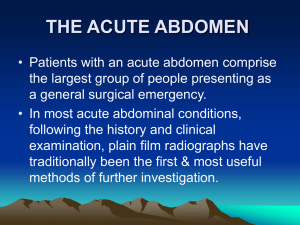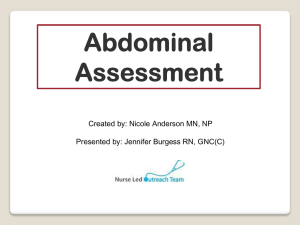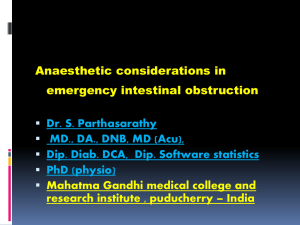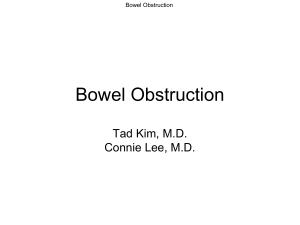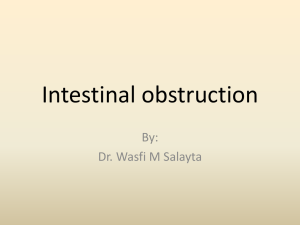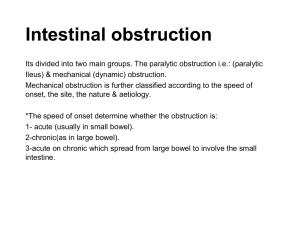Abdominal X-Ray - Yale School of Medicine
advertisement
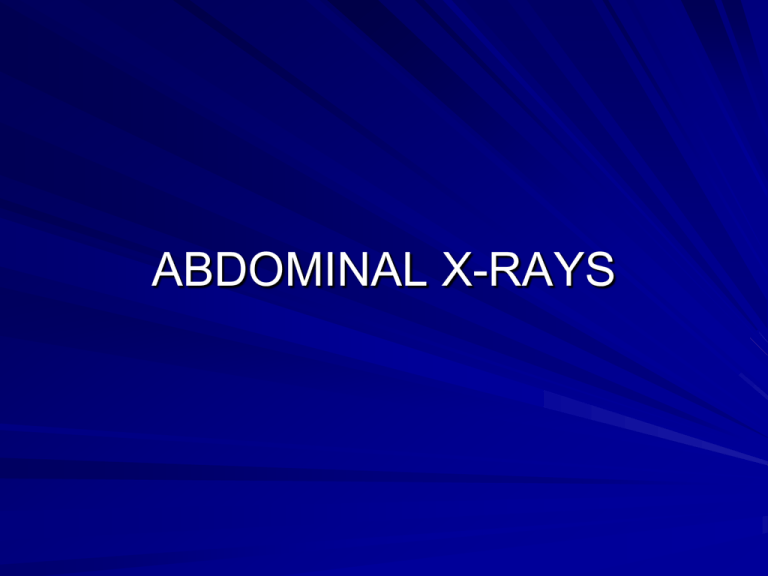
ABDOMINAL X-RAYS Plain abdominal X-rays not as useful as plain chest X-rays because of contrast factors Lung pathology (pneumonia, CA, effusion, etc.) is usually of soft tissue/fluid density and is visible on X-ray against natural contrast agent of air in lungs In abdomen, background is soft tissue/fluid density, and pathology is often of same density, hence usually invisible on X-ray Plain abd. X-rays usually will be of help only for pathology involving gas/air or calcium – Gas/air: e.g., bowel obstruction, free air – Calcium: e.g., renal stones Following shows calcified gallbladder stones (visible against soft tissue background) Although these stones are atypical in that most gallstones are not visible on X-ray (only 10-15% have enough calcium salts to be seen), they are otherwise typical (in location of GB, the calcium is layered, the stones have facets or flat sides) The following 3 images constitute a 3-way of the abdomen – Supine abdomen (KUB, flat plate of abd.) – Upright abdomen – Upright CXR Each of the 3 images has key role to play – Supine abd.: best detail image – Upright abd.: shows air-fluid levels – Upright CXR: shows free air under diaphragm If patient can’t be positioned for upright imaging, lateral decubitus abdomen is done with right side up and horizontal beam X-ray to look for free air and air-fluid levels Following lateral decubitus image shows a large amount of free intraperitoneal air and fluid Following 2 images are 2-way of the abdomen (supine and upright abdomen) Note the dilated loops of small bowel containing air-fluid levels, but with small amounts of air in non-dilated colon which has no air-fluid levels, indicating a small bowel obstruction The findings of obstruction (regardless of level of GI tract, on X-ray or CT) – Dilated bowel – Air-fluid levels – A transition (dilated bowel and levels proximally, but not distally), although on X-ray the lesion and transition are usually not directly visible) Although CT is usually used when there is a high suspicion of bowel obstruction, plain X-rays are still used frequently for cases of lower suspicion (as a “rule-out”) Distinguish bowel obstruction from ileus, because patient with mechanical obstruction should be on surgical service and may need surgery, but not ileus Both have dilated bowel and air-fluid levels, but ileus lacks a transition (tends to have dilatation and levels throughout) Following is a case of ileus. Although there is a lot of bowel gas, it extends throughout the small and large bowel, without a transition Also, the small bowel loops have a polygonal pattern rather than showing longer distended loops as would be typical of mechanical obstruction Causes of paralytic ileus – – – – – Peritoneal irritation (peritonitis, pancreatitis, hemoperitoneum,) Recent abdominal surgery Hypokalemia Acute bowel ischemia ? Neurologic mechanism (spinal fracture, passing ureteral stone, baby delivery) Causes of mechanical small bowel obstruction – Adhesions from prior abdominal surgery – Incarcerated hernia – Tumor Primary (carcinoid, lymphoma, adenocarcinoma) Metastatic (e.g., ovarian CA) – – – – – – Stricture (chronic ischemia, Crohn dis., radiation, endometriosis) Secondary involvement in adjacent inflammation (appendicitis, diverticulitis) Gallstone ileus Volvulus Intussusception Bezoar Following 2-way of the abdomen shows large bowel obstruction Note dilated colon, air-fluid levels, and a transition (sigmoid colon is not dilated), the 3 elements of obstruction More important to promptly diagnose large bowel compared to small bowel obstruction – SBO can be decompressed by NG tube, but harder to do for LBO, especially with competent ileocecal valve (50%of time) – Cecum may rupture (Laplace’s Law), sending feces into peritoneal cavity To confirm colonic obstruction, a limited barium enema is a quick, simple, cheap, definitive exam, not requiring bowel prep Following are images of barium enema on same patient who had preceding 2-way of abdomen BE shows a short-segment obstructing lesion with a polypoid intraluminal component, indicating a sigmoid colon cancer For comparison to the colon obstruction on the prior patient, following is a 2-way of the abdomen on a patient with toxic megacolon due to ulcerative colitis Although similar to the LBO, note distension of sigmoid and very irregular, nodular, thickened mucosa (clinical presentation would be different also) Patient had colectomy shortly after these Xrays because of progressive dilation of cecum Causes of sigmoid colon obstruction – Adenocarcinoma of colon – Diverticulitis – Sigmoid volvulus Following is KUB on patient with sigmoid volvulus – Two-part obstruction (closed loop obstruction of twisted sigmoid and upstream colon obstruction) – Note massively dilated sigmoid, because acute obstruction typically occurs on background of chronic constipation and chronic colonic dilatation) Gas “out of place” may be seen on abdominal X-rays – Bowel wall – Portal vein – GB and biliary tree – Urinary tract Following shows gas in wall of small bowel, usually indicating dead bowel, particularly if patient looks sick Following case shows gas in portal vein branches in liver, usually due to dead bowel in a very sick patient, and often followed by death Branching pattern of gas in liver can also be in biliary tree, but most commonly this is incidental finding in patients with prior papillotomy or biliary bypass surgery. On following KUB most remarkable finding is easy visibility of outside wall of some of the bowel loops, indicating that outside wall is outlined by air (pneumoperitoneum) The upright CXR confirms a large amount of free intraperitoneal air (secondary to perforated diverticulitis) Note the widened superior mediastinum on the CXR, an incidental old finding on this elderly female, due to intrathoracic goiter.


